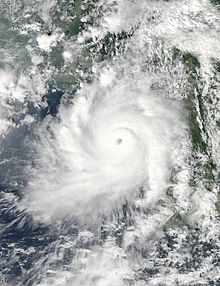 Cyclone Giri near peak intensity on October 22 | |
| Meteorological history | |
|---|---|
| Formed | October 20, 2010 |
| Dissipated | October 23, 2010 |
| Extremely severe cyclonic storm | |
| 3-minute sustained (IMD) | |
| Highest winds | 195 km/h (120 mph) |
| Lowest pressure | 950 hPa (mbar); 28.05 inHg |
| Category 4-equivalent tropical cyclone | |
| 1-minute sustained (SSHWS/JTWC) | |
| Highest winds | 250 km/h (155 mph) |
| Lowest pressure | 922 hPa (mbar); 27.23 inHg |
| Overall effects | |
| Fatalities | 157 direct, 10 indirect |
| Damage | $359 million (2010 USD) |
| Areas affected | Myanmar, Bangladesh, Thailand, Yunnan |
| IBTrACS | |
Part of the 2010 North Indian Ocean cyclone season | |
Extremely Severe Cyclonic Storm Giri (IMD designation: BOB 04, JTWC designation 04B, also known as Cyclone Giri) was a powerful tropical cyclone in terms of 1-minute sustained wind speed which caused catastrophic damage in parts of Myanmar in late October 2010. Originating from an area of low pressure over the Bay of Bengal on October 19, the system began as a weak depression 250 km (155 mi) south of Myanmar. Over the following few days, the depression underwent explosive intensification, reaching its peak intensity with winds of 195 km/h (120 mph 3-minute sustained) on October 22. Cyclone Giri made landfall roughly 50 km (31 mi) northwest of Kyaukpyu, shortly after peaking. Within hours of moving onshore, the system had substantially weakened. By the following day, Giri had degenerated into a tropical depression and the final advisory was issued on the storm.
Unlike during Cyclone Nargis in 2008, the Government of Myanmar took steps to ensure the safety of residents in the path of Cyclone Giri. An estimated 53,000 are believed to have evacuated Kyaukphyu before the arrival of the storm. Throughout central Myanmar, at least 157 people are known to have been killed by Giri. Thousands of structures near where the storm made landfall were destroyed, leaving more than 70,000 people homeless. An international relief effort began shortly after the storm passed to assist survivors of the storm. Local and foreign media initially criticized the Myanmar government for not giving residents enough warning of the storm and then for keeping quiet on the situation, but the focus later shifted to the loss of life and relief efforts.
